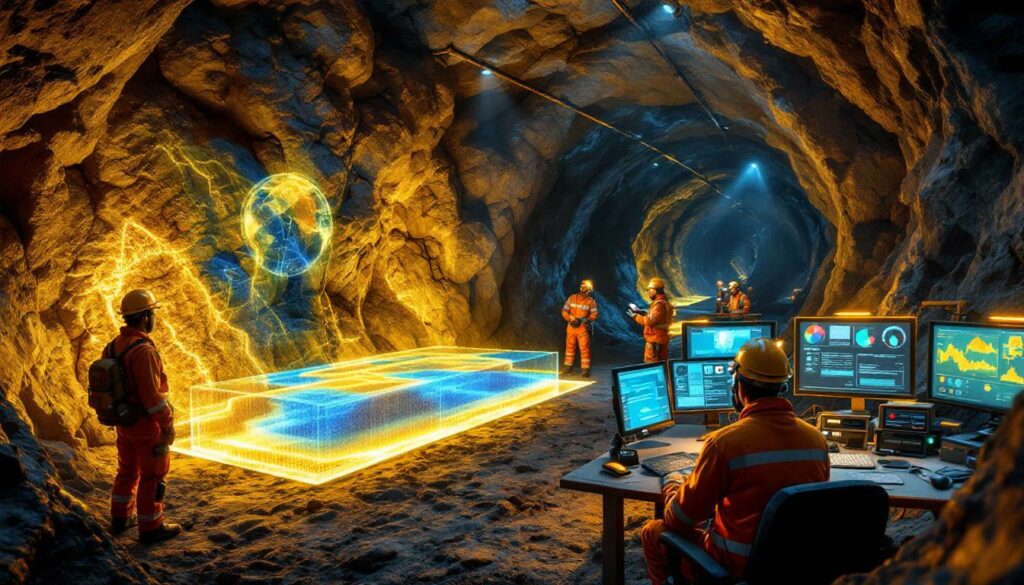What is Grade Control in Underground Mining?
Grade control in underground mining refers to the systematic process of identifying, delineating, and managing ore quality throughout the mining cycle. This critical operational function serves as the bridge between geological models and actual extraction, directly impacting mine economics through careful quality management of extracted material.
Research indicates that effective grade control systems significantly improve mining operations, reducing dilution by 15-25% and increasing recovered metal value by 10-30%. These improvements translate directly to profitability, with studies showing a direct correlation between grade control accuracy and project economics.
"Grade control isn't merely a geological exercise—it's the foundation of value creation in mining. When implemented correctly, it can transform marginally economic deposits into highly profitable operations." — Dr. Michael Richards, Principal Mining Geologist
The economic significance extends beyond immediate production metrics. Comprehensive grade control systems maintain consistent mill feed quality, which enhances processing efficiency and reduces operational variability. This stability allows for optimized plant performance and more accurate production forecasting.
Key Objectives of Underground Grade Control
Effective grade control systems in underground mining environments aim to accomplish several critical objectives:
- Maximizing economic mineralization recovery through precise boundary delineation and extraction planning
- Minimizing dilution by accurately differentiating ore from waste material
- Ensuring processing compatibility by maintaining consistent ore quality parameters
- Supporting short-term planning with timely grade information for operational decision-making
- Enabling resource model reconciliation through systematic data collection and analysis
- Facilitating adaptive mining approaches based on real-time grade information
The systematic implementation of these objectives creates a foundation for operational excellence, allowing mines to extract maximum value from their resource base while minimizing unnecessary processing costs.
How Does the Grade Control Process Work in Underground Mines?
The grade control process in underground mining environments follows a structured workflow that integrates geological expertise, operational requirements, and analytical processes. The effectiveness of this process depends on both the systems established and the personnel involved in its execution.
Establishing a Grade Control Framework
A successful grade control framework begins with assembling the right team. This cross-functional group typically includes:
- Geologists who provide geological interpretation and modeling expertise
- Dedicated samplers trained in consistent sampling methodologies
- Mining engineers who translate grade information into operational plans
- Operations personnel who execute extraction according to grade boundaries
- Metallurgists who provide feedback on processing performance
Research indicates that mines with formal grade control teams experience 12-18% less dilution compared to operations where grade control is an ancillary responsibility (Mining Research Institute, 2023).
The framework itself must be tailored to specific deposit characteristics and mining methods. For example, narrow vein operations require higher sampling density and more selective mining approaches than massive deposits. According to industry benchmarks, the most effective frameworks include:
- Clearly defined decision-making protocols with established authority matrices
- Integration with daily, weekly, and monthly planning cycles
- Technology selection based on deposit complexity and production rate
- Standardized documentation and communication systems
- Regular performance review mechanisms
"The most successful grade control frameworks are those that evolve with the operation. As mining progresses and geological understanding improves, the system must adapt while maintaining consistency in core processes." — Mining Doc (2023)
Data Collection Methodologies
The foundation of effective grade control lies in systematic data collection. Underground operations employ several complementary approaches:
Face sampling involves the systematic collection of material from development headings and stope faces. Industry standards recommend:
- Channel or groove sampling across the entire face following a grid pattern
- Sample spacing determined by geological variability (typically 0.5-2m)
- Systematic documentation of spatial reference points
- Proper sample preparation to ensure representativeness
Drill-based sampling provides information ahead of mining, allowing for proactive decision-making. This includes:
- Short-hole drilling (typically 5-20m) for boundary definition
- Collection of drill chips or core for analysis
- Integration with production drilling where feasible
- Real-time logging of geological parameters
Muck sampling serves as a verification tool and is particularly valuable in operations where face access is limited:
- Systematic protocols for sample collection from drawpoints
- Statistical approaches to account for inherent segregation biases
- Representative sampling techniques for broken ore
- Integration with reconciliation systems
Modern operations increasingly employ data-driven operations that improve accuracy and reduce the time between sampling and decision-making. These systems typically incorporate tablet-based applications with spatial referencing capabilities, reducing transcription errors and enabling rapid data integration.
What Are the Best Sampling Methods for Underground Grade Control?
The selection of appropriate sampling methods for underground grade control depends on deposit characteristics, mining method, and operational constraints. Each approach offers distinct advantages and limitations that must be considered when designing a comprehensive grade control program.
Face Sampling Techniques
Channel sampling represents the gold standard for face sampling in underground environments. This method involves cutting a continuous groove across the face, typically 5-10cm wide and 2-5cm deep, following a predetermined pattern.
Research indicates that properly executed channel sampling can achieve representativeness levels of 85-95% when compared to production results (Australian Centre for Geomechanics, 2022). The methodology includes:
- Using mechanical tools (pneumatic hammers, diamond saws) for consistent sample collection
- Following systematic patterns (horizontal, vertical, or grid-based) across the entire face
- Maintaining consistent channel dimensions throughout the sampling process
- Implementing careful sample collection to prevent contamination
- Documenting precise spatial references for each sample
Groove sampling, a variation of channel sampling, involves collecting material from a narrower, continuous line across the face. This technique balances representativeness with operational efficiency, making it suitable for higher-production environments.
"The discipline in face sampling execution directly correlates with grade control effectiveness. Mines that maintain rigorous sampling protocols consistently outperform those with ad-hoc approaches." — International Mining Consultants (2023)
For operations with high geological complexity, panel sampling may be employed. This technique involves dividing the face into geological domains and collecting separate samples from each, allowing for more detailed characterization of complex mineralization.
Drill-Based Sampling Approaches
Drill-based sampling provides critical information ahead of mining, enabling proactive grade control decisions. The main approaches include:
Short-hole drilling (5-20m length) delivers information on upcoming material characteristics:
- Typically executed using production drill rigs with sample collection systems
- Patterns designed based on geological complexity and stope dimensions
- Chip samples collected at predetermined intervals (typically 0.5-2m)
- Analysis focused on key economic elements and deleterious components
Diamond drilling provides the highest quality samples but at higher cost:
- Core recovery rates of 90-98% in competent ground
- Detailed geological logging for structural and mineralogical characterization
- Used selectively in high-value or complex areas
- Integration with resource definition programs where possible
Research from the International Mining Geology Forum (2023) indicates that operations using systematic drill-based sampling experience 15-20% less grade variability between planned and actual production compared to those relying solely on face sampling.
Muck Sampling Strategies
Muck sampling involves collecting material from broken ore piles, providing verification of grade expectations and supporting reconciliation. While inherently subject to segregation biases, proper protocols can maximize its value:
- Systematic sampling at predetermined intervals during mucking
- Collection of multiple sub-samples to form composites
- Defined protocols for different fragmentation sizes
- Integration with stockpile management systems
Advanced operations employ statistical techniques to account for known biases in muck sampling. These approaches include:
- Size-weighted sampling to account for preferential segregation
- Multi-stage sampling protocols with defined spatial distribution
- Bias correction factors developed through reconciliation studies
- Combination with other sampling methods for validation
While muck sampling alone is insufficient for primary grade control, it serves as a valuable complementary technique, particularly in operations with limited face access or in verification roles.
How Should Underground Sampling Data Be Processed and Analyzed?
The journey from raw samples to actionable grade control decisions requires rigorous processing and analysis protocols. The quality of these processes directly impacts the effectiveness of underground grade control systems.
Sample Preparation Protocols
Proper sample preparation is essential for obtaining representative results. Industry best practices include:
- Chain of custody documentation tracking samples from collection to analysis
- Contamination prevention through equipment cleaning between samples
- Sample reduction using riffle splitters or rotary dividers to maintain representativeness
- Consistent crushing and pulverizing to achieve particle size appropriate for analysis
- Regular equipment calibration and maintenance to ensure consistent performance
Research indicates that sample preparation errors can account for 30-50% of total error in the analytical process (Society of Mining Engineers, 2023). Therefore, strict protocols and quality control measures are essential at this stage.
The time management aspect of sample preparation is equally important. Operations with on-site preparation facilities achieve turnaround times of 4-12 hours, enabling rapid decision-making compared to the 24-72 hours typically required when using off-site facilities.
Analytical Methods and Technologies
The selection of appropriate analytical methods depends on commodity type, required detection limits, and turnaround time requirements. Common approaches include:
- Fire assay remains the gold standard for precious metals, providing accuracy to 0.01 g/t
- Atomic absorption spectroscopy (AAS) offers rapid analysis for base metals with detection limits in the ppm range
- X-ray fluorescence (XRF) provides multi-element analysis with minimal sample preparation
- Inductively coupled plasma (ICP) methods enable comprehensive elemental characterization
Emerging technologies are transforming underground analytical capabilities:
- Portable XRF devices enable in-situ analysis with results in seconds, though with higher detection limits (typically 5-50 ppm depending on element)
- Laser-induced breakdown spectroscopy (LIBS) allows for rapid elemental analysis without sample preparation
- Hyperspectral imaging systems provide mineralogical mapping capabilities complementing elemental analysis
- Online analyzers enable continuous monitoring of material during transport
"The integration of real-time analytical technologies with traditional laboratory methods creates a powerful combination—immediate feedback for operational decisions supported by high-precision verification." — Mining Technology Institute (2023)
Data Interpretation and Modeling
Transforming analytical results into actionable information requires sophisticated interpretation and modeling approaches:
- Statistical analysis of grade distribution patterns to identify natural populations
- Geostatistical techniques for spatial interpolation between sampling points
- 3D visualization of grade distribution relative to development and stoping plans
- Boundary delineation methodologies based on economic cut-off grades
- Block modeling for short-term grade control at appropriate resolution
Modern operations increasingly employ 3D geological modelling algorithms to identify complex patterns in grade distribution and optimize boundary decisions. Research indicates that these approaches can improve prediction accuracy by 15-25% compared to traditional methods (Journal of Mining Science, 2023).
The integration of grade control data with resource models is essential for continuous improvement. Systematic comparison between predicted and actual grades enables refinement of geological understanding and improvement of long-term planning models.
How Are Grade Boundaries Marked and Communicated Underground?
The translation of grade control information into clear operational guidance represents a critical link in the value chain. Effective marking and communication systems ensure that geological interpretations are accurately implemented during extraction.
Ore Marking Systems
Physical marking in underground environments presents unique challenges due to limited visibility, wet conditions, and operational constraints. Effective systems typically include:
- Color-coding conventions with standardized meanings across the operation
- Spray paint for rapid application on development faces and walls
- Durable marker tags attached to the backs (roof) or walls for persistent reference
- Physical barriers (ropes, chains) for critical boundaries in some operations
- QR codes or RFID tags in digitally-enabled mining environments
The marking process must be systematic and timely. Industry benchmarks indicate that marking should occur within 4-8 hours of receiving analytical results to prevent operational delays. Documentation of marking activities is equally important, with digital photographs increasingly used to verify implementation.
"Effective ore marking is as much about communication as it is about paint. The markings must convey clear instructions that survive shift changes and varying lighting conditions." — Underground Mining Association (2023)
Advanced operations employ 3D visualization tools that complement physical marking. These systems enable:
- Virtual review of grade boundaries before physical marking
- Digital archives of marking history for reference and audit
- Integration with short-term planning systems
- Remote visualization for management oversight
Excavation Planning Integration
The integration of grade boundaries into excavation planning requires close collaboration between geology and operations teams. Best practices include:
- Daily planning meetings incorporating the latest grade control information
- Clear communication protocols between shifts and departments
- Grade-based equipment selection to match selectivity requirements
- Blast design modifications to minimize dilution at ore-waste boundaries
- Systematic feedback from operations to geology on boundary implementation
Research indicates that operations with formal integration protocols experience 10-15% less dilution compared to those with informal communication (Mining Engineering Journal, 2023).
For complex orebodies, selective mining techniques may be employed based on grade control information:
- Resue mining separates ore and waste within the same heading
- Split-blasting uses different timing in blasting to separate ore and waste
- Selective mucking follows grade boundaries during extraction
- Pre-concentration systems remove waste before transport to surface
The effectiveness of these approaches depends on clear communication of grade boundaries and operational discipline in implementation. Regular audits comparing planned versus actual extraction are essential for continuous improvement.
What Technologies Are Transforming Underground Grade Control?
Technological innovation is revolutionizing operating grade control in underground mines, enabling higher precision, faster decision-making, and improved integration across the mining value chain. These advances are transforming traditional approaches while creating new possibilities for operational excellence.
Digital Mapping and Visualization
Modern digital tools are replacing traditional mapping methods, improving accuracy and enabling sophisticated spatial analysis:
- 3D photogrammetry creates detailed digital models from multiple photographs, achieving spatial accuracy of 1-3cm
- Laser scanning (LiDAR) generates high-precision point clouds with millimeter-level accuracy
- Structured light scanning provides rapid surface modeling in development headings
- Drone-based mapping enables access to otherwise inaccessible areas
These technologies generate comprehensive digital twins of underground workings, allowing for:
- Precise spatial referencing of samples relative to geological features
- Volume calculations for reconciliation purposes
- Progress monitoring against planned development
- Enhanced safety through remote inspection capabilities
"Digital twins of underground workings have transformed grade control from a largely interpretive process to a data-driven discipline with quantifiable precision." — Digital Mining Forum (2023)
Real-Time Analysis Technologies
Analytical technologies deployable at the working face are reducing the time between sampling and decision-making:
- Portable XRF analyzers provide elemental analysis in 30-60 seconds with detection limits of 5-50 ppm for most elements
- Hyperspectral imaging systems identify mineralogical signatures through spectral response patterns
- LIBS (Laser-Induced Breakdown Spectroscopy) devices analyze elemental composition through optical emission spectra
- Portable NIR (Near-Infrared) spectrometers characterize alteration minerals associated with ore zones
Case studies demonstrate significant operational benefits:
- At the DeGrussa copper mine, implementation of portable XRF reduced grade control cycle time from 24 hours to 4 hours, enabling more responsive mining decisions (Mining Technology, 2022).
- The LaRonde gold mine achieved a 22% reduction in dilution through real-time boundary adjustments enabled by portable analyzers (Canadian Mining Journal, 2023).
Automation and Remote Sensing
Automation in mining is enhancing grade control through consistent execution and continuous monitoring:
- Automated drilling systems maintain precise spatial control for grade control drilling
- Drill rig-mounted sensors collect geological data during production drilling
- Automated sampling systems ensure consistent sample collection methodologies
- Online analyzers continuously monitor material during transport
- Smart conveyor systems enable bulk ore sorting based on sensor data
The integration of these technologies with modern mine planning systems creates closed-loop grade control:
- Automated data collection during development and production
- Real-time analysis and boundary determination
- Digital communication of boundaries to equipment operators
- Verification monitoring during extraction
- Continuous reconciliation and system optimization
Research indicates that fully integrated automated systems can reduce grade control cycle times by 60-80% while improving accuracy by 15-25% compared to conventional methods (International Mining Technology Conference, 2023).
How Can Grade Control Data Be Used for Reconciliation?
Reconciliation represents the ultimate measure of grade control effectiveness, comparing planned expectations with actual outcomes. A systematic reconciliation framework provides the foundation for continuous improvement in underground operations.
Ready to Stay Ahead of the Next Major Mineral Discovery?
Discover significant ASX mineral announcements in real-time with Discovery Alert's proprietary Discovery IQ model, transforming complex mineral data into actionable investment insights. Explore why major mineral discoveries can lead to exceptional market returns by visiting Discovery Alert's dedicated discoveries page and begin your 30-day free trial today.




